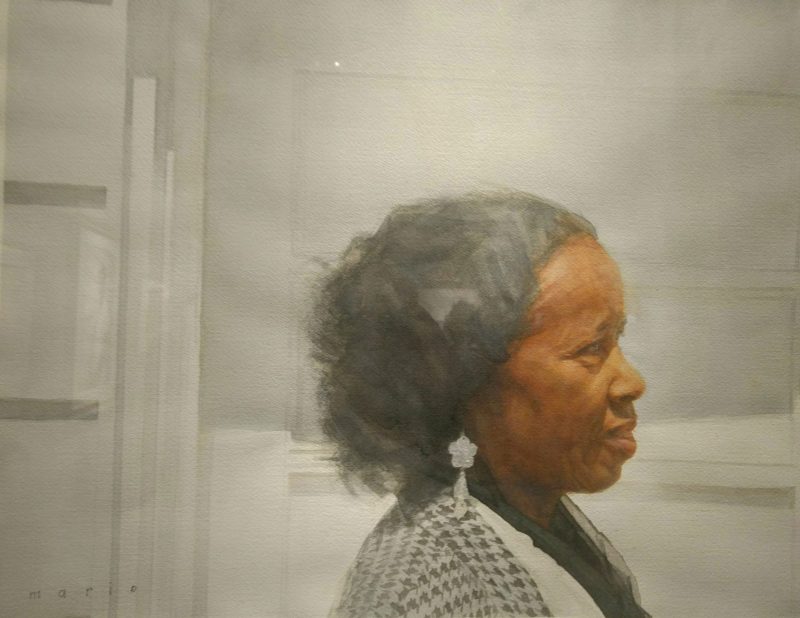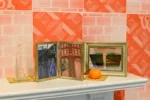“Just like my grandfather, Mario has the incredible ability to capture the emotional state,” revealed Victoria Browning Wyeth, granddaughter of Andrew Wyeth. “Mario paints with his heart and soul.”
Before the Florence Academy of Art (US branch, in Jersey City, NJ) opened An American Tradition: The Art of Mario Andres Robinson, Victoria Browning Wyeth presented a special lecture that connected Andrew Wyeth’s legacy to Robinson in a dimly lit classroom where classical paintings of white bodies prevail. Browning Wyeth, however, included several sketches and paintings of Wyeth’s close Black friend, Willard Snowden. In addition to his landscapes of Rockland, ME and Chadds Ford, PA, Wyeth was extremely devoted to portraiture, to Snowden most of all, although “Christina’s World” is often considered his most famous work. Last year, at the Met Breuer, I saw Wyeth’s striking tempera Snowden portrait entitled “Grape Wine,” hanging alongside Kerry James Marshall’s other inspirations during the run of Mastry, Marshall’s 2017 retrospective at the museum. Thus, it makes perfect sense that Mark Andres Robinson too would find Wyeth a worthwhile influence.
Robinson — who discovered Wyeth in the W’s of his local library’s artist books section — follows a classical path, realistically rendering Black and brown faces and bodies with tender precision. Inside the one room gallery at the Florence Academy, his modest sized paintings — all pleasantly framed — span four, burnt umber painted walls. The paintings contain portraits of people and buildings from his home state of Oklahoma, and with the exception of one gestural pencil drawing, the works are all watercolor on paper — a most challenging medium that Robinson has mastered well.
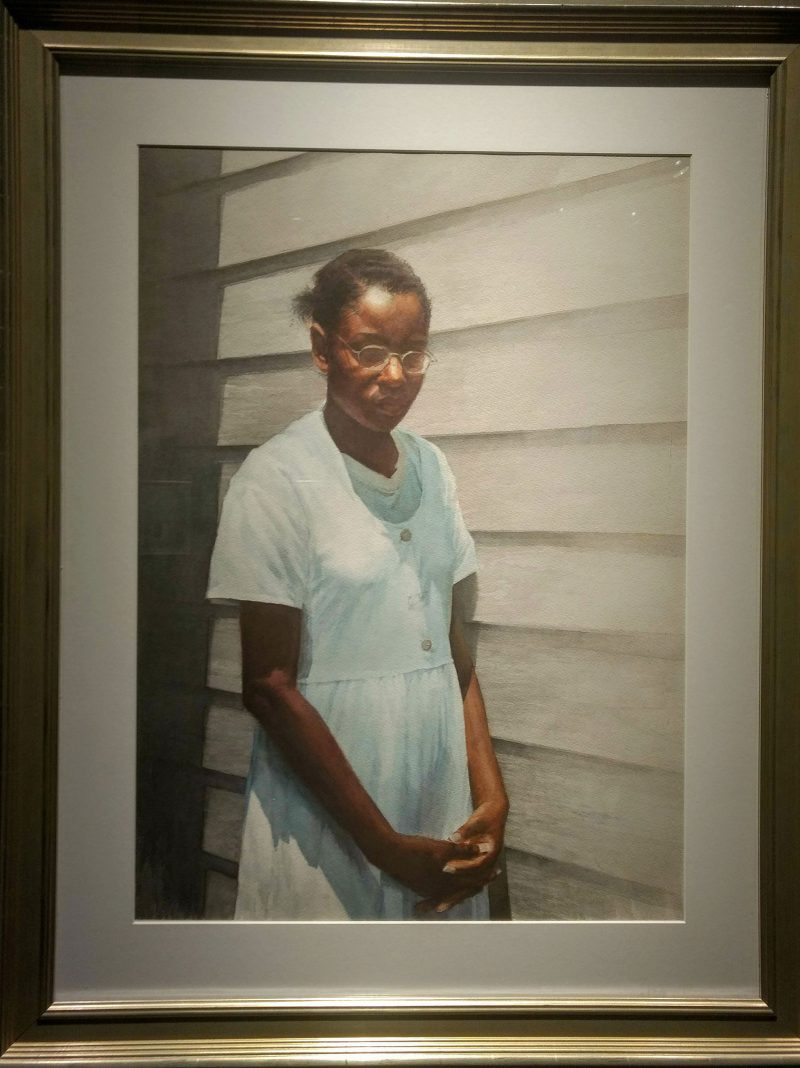
The luminous portraits of brown women are especially gratifying. In them, Robinson captures beyond the moments, the light and shadow as it moves across their faces. For example, in “Freedom,” a young girl stands against shutters, her hands demurely clasped, her eyes downcast, and her dress modest and simple. Yet every part of her is attended to. Each strand and curl of her dark hair, the gold in her rounded glasses, the passive hands, all are relevant. The fetching light source enters from the right side, surrounding her humbled posture in an almost angelic brilliance. Through compelling, committed details builds the sense that this young girl’s existence is valid, sacred even. She matters in a society that often tells her different.
“Evelyn” calls to mind Zora Neale Hurston’s essay “How it Feels To Be Colored Me.” In fact, Glenn Ligon repetitively smudges a particular line — “i feel most colored when I am propped against a sharp white background” — into an abstract composition. Whereas Robinson’s realistic subject is positioned in a profile further mirroring Wyeth’s keen awareness of finessing contrast. Evelyn’s light brown skin, black hair, and black shirt retain the same devout commitment as with “Freedom.” In her carefully detailed face and hair, Robinson layers and layers the watercolor on the heavy Arches paper, working the surface to fullest extent of its capability.
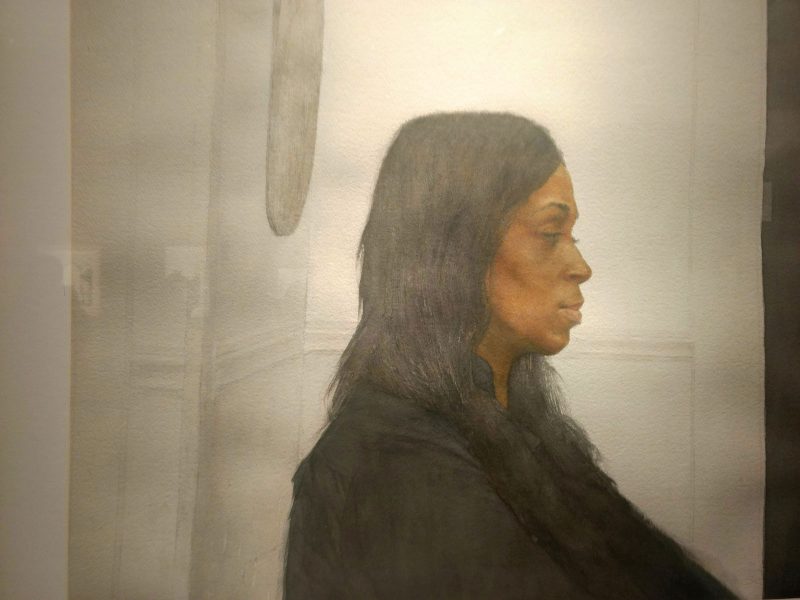
“I just want to express our humanness, our joy,” Robinson said.
Most of Robinson’s portraits and landscapes are subdued and portray a quiet dignity. “Peachtree and Pine” definitely embodies sentimental joy, containing surprising colors beside an elder bald man dressed in a simple t-shirt. The bright red, soft yellow, and cool blue ornaments are on the figure’s left, geometric shapes affixed to the building behind him. His face, in a three quarter view, contains full, purplish lips curved into a smile and dark eyes staring out at the viewer with a hint of mischievousness.
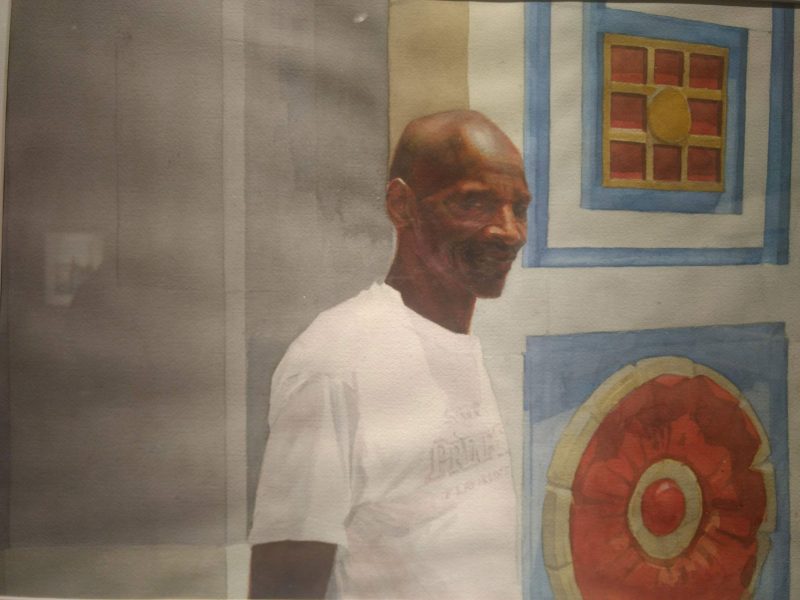
While Wyeth’s classical techniques and penchant for sincere accuracy weave into Robinson’s work, it is an impressive testament to include brown bodies as the focal point. Brown bodies both elevate their ordinariness and absence. Robinson then relays an important message in the classroom that ordinarily puts white bodies center stage. His brown body figures have the right to belong in that exclusive space.
An American Vision: The Art of Mario Andres Robinson is up until May 10, 2019 at The Florence Academy of Art, 888 Newark Avenue, 3rd Floor, Jersey City, NJ. Gallery hours are Monday through Friday, 9-5PM.
More photos
